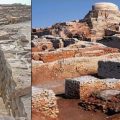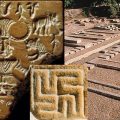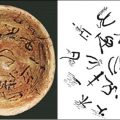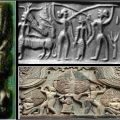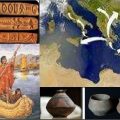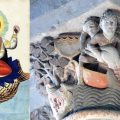Indus Valley Cultural Elements in Minoan Crete: Was it Due to Migration?
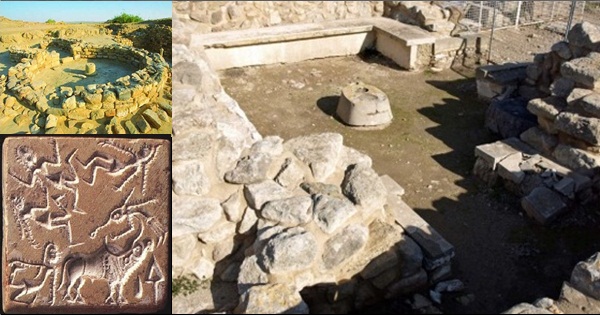
Bull-Leaping
My interest in the Minoan civilization of Crete was sparked when I noted a conspicuous parallel between the Indus and Minoan cultures – that of the popularity of the sport of bull-leaping. Indus seals from c.2600 BCE onwards show acrobats leaping over a bull, while in Cretan art bull-leaping appears at the beginning of the Late Bronze Age in c.1700 BCE.
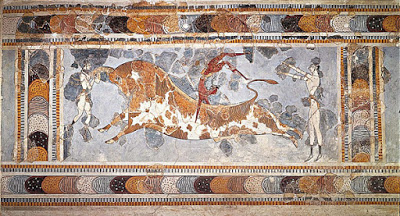
Fig 1: The bull-leaping fresco at the Great Palace at Knossos, Crete, dated to c.1450-1400 BCE. Two men are positioned at each end of the bull, while another somersault over the bull. Public domain image.
Bull-leaping was extremely popular in Minoan Crete. At the Great Palace at Knossos, bull-leaping was prominently depicted on frescoes. Archaeologists believe that the large ceremonial courtyard at the center of the Knossos palace complex may have served as the bull-ring, as the major entrances leading to the courtyard were adorned with paintings of processions and bull-leaping.

Fig 2: Impression of a Banawali seal from c.2300 – 1700 BCE, showing an acrobat leaping over a bull. Source: UMESAO 2000:88, No. 335
This reminded me of the Indus Valley site of Dholavira, where archaeologists have found a large ceremonial ground furnished with tiered, stepped, stands on all four sides.[1] A ceremonial pathway led from the castle to the stadium. Could it be that the ceremonial ground at Dholavira also served as an arena for bull-leaping games?
Another piece of Minoan art that caught my attention was a three-dimensional bronze figurine of a Minoan bull leaper from c.1600 BCE, fashioned using the lost wax method. It is well-known that the Indus artisans had perfected this technique, well over a thousand years earlier. The famous “dancing girl” figurine of Mohenjo-Daro from c.3000 BCE was cast using the lost-wax method. I wondered how the Minoans acquired the skill to make these bronze statues in the second millennium BCE, when Crete had no natural sources of copper or tin to make bronze, and relied on an extensive maritime network to obtain these materials.
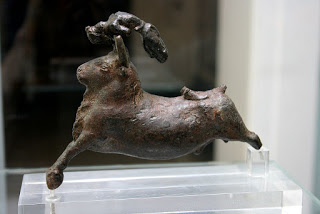
Fig 3: Bronze figurine of a Minoan bull leaper, Crete c. 1600 BCE, made using the lost-wax method. Source: Wikimedia Commons / Mike Peel CC-BY-SA 4.0
Is it possible that a group of Indus tribes settled in Crete sometime around 1700 BCE, soon after the Indus Valley civilization started to collapse at around 1900 BCE, and took with them their cultural practices and technological skills? Bull-leaping and the lost-wax method of bronze casting appears in Minoan Crete roughly 200 years after the collapse of the Indus civilization. So, the timing is just about right. There is a sufficiently large window of time for a migration to have taken place.
As I discussed in my earlier article “Bull-Leaping: Did it spread from the Indus Valley to Syria, Egypt, and Crete?”[2], the collapse of the Indus Valley had set off a chain of migrations out of the most densely populated civilization of the ancient times. The Kushites moved from the Indus Valley to Ethiopia, and probably played a part in introducing bull-leaping in Avaris in the 15th century BCE, while the Mitanni migrated to Syria and Turkey where bull-leaping images start appearing from the 15th century BCE as well.
Could it be, therefore, that certain Indus tribes migrated to Minoan Crete sometime around 1700 BCE? If so, elements of the Indus Valley culture should be reflected in the social, religious, and technological aspects of the Minoan society. In this brief comparative study of the two cultures, I have identified a number of interesting parallels between the two civilizations, which indicates deep cultural interactions.
Water Management Techniques
Although the Minoan civilization flourished on the Aegean island of Crete from around c.3600 BCE, it was only around 1900 BCE (the Protopalatial Period) that they started constructing large palaces. A terrible cataclysm in Crete, possibly an earthquake, led to the utter destruction of the old palaces. This was followed by the Neopalatial Periodfrom 1700 BCE – 1450 BCE, which marked the apex of the Minoan civilization.
One of the most notable characteristics of the Minoan palaces of the Neopalatial Period was their highly-sophisticated water management techniques, which are astonishingly similar to those found in the Indus Valley cities from c.3000 BCE.
The palace at Knossos (Crete), as well as the houses of the Indus Valley cities, had toilets on the upper floors from where the waste water was carried by vertical terracotta pipes to a network of underground sewers. In Crete, the sewerage system was built of stone and lined with cement, while in the Indus cities both bricks and stones were used. The sewers were provided with manholes, through which municipal workers could enter the sewers and remove the sullage. The Minoans and the Indus inhabitants also built large storm water drains for carrying the rain water away from the city.

Fig 4: Water Management Systems in Minoan Crete and IVC
For drinking water, the Minoans and the Indus people built numerous wells, as well as huge reservoirs which were filled using rain-water harvesting techniques. Dholavira (Indus Valley) saw a remarkable innovation – a series of dams diverted the river waters to fill up a complex network of 16 reservoirs that surrounded the town. Aqueducts brought freshwater from the springs to the palace at Knossos, which was distributed throughout the palace through a network of terracotta piping located beneath the palace floors. In Dholavira, aqueducts carried the waters from the reservoirs to the heart of the city, while canals carried them into the fields for irrigation.
All the water management techniques employed by the Minoans during the Neopalatial Period had been in use in the Indus Valley since c.3000 BCE.
How did the Minoans acquire these sophisticated hydraulic technologies at the beginning of the Neopalatial Period in c.1700 BCE, when none of their neighboring cultures in the Mediterranean possess them? The technologies appear in their mature state, without a corresponding period of development. Could there have been an infusion of technology from outside Crete?
If so, the only place from where these water management techniques could have been introduced into Crete was the Indus Valley, for it was the only contemporary civilization that had implemented these technologies since c.3000 BCE.
The Goddess Cult
Goddess worship was popular in the Indus Valley, as well as in Minoan Crete, as indicated by the discovery of a large number of female terracotta figurines, at least some of which were probably goddess figures.
A particularly important Minoan deity was the Snake Goddess – a name given to a striking terracotta figurine depicting a woman holding a snake in each hand. Her figurines were found only in house sanctuaries, indicating that she was a household cult goddess. Another terracotta figurine identified as the Snake Goddess has snakes entwined around her body.
An almost exact counterpart of this deity in India is called Manasa. She is still a popular household deity amongst the village folks in the eastern part of India, particularly in Bengal. Manasa is the goddess of snakes, often depicted holding snakes with both hands, and attended by snakes. She provides protection from snake bites and immunity from danger. She is eulogized as the most enchanting and graceful in the three worlds (Jagadgauri), possessing supreme wisdom (Maha Jnanayuta), who can even revive the dead (Mrtasamjivani).
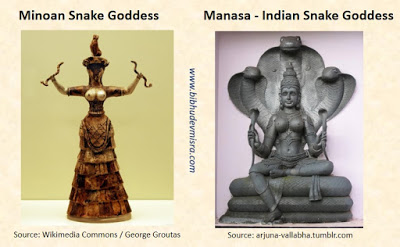
Fig 5: Minoan and Indian Snake Goddess.
A hymn dedicated to Manasa, quoted by Kasirama Vacaspati, correlates very closely to the Minoan terracotta figurines of the Snake Goddess:
“I take shelter unto the goddess, the mother of Astika. She has a young child (on her lap). She shines like the golden lotus. Huge snakes always attend on her on all sides. She has full and prominent bosoms. She holds two snakes in her two hands. She has a smiling countenance, and is decorated with the ornaments of shining snakes.”[3]
Manasa was popular amongst the tribal cultures as well, and was worshipped by the Buddhists as the serpent goddess Janguli. Her worship extends back to the very early periods of history, for even in the Atharva Veda (X.4.14; X.4.24) a poison-dispelling goddess called Taudi / Ghrtaci is mentioned. It is possible, therefore, that Indus sea-faring traders carried the worship of Manasa to Crete. A Snake Goddess with a similar iconography and enjoying popular appeal is rarely to be found in other cultures. Moreover, Manasa has been traditionally popular amongst the mercantile class of Bengal, and the Minoans were also a mercantile people engaged in overseas trade.
Another Minoan goddess is called the “Mistress of Animals”. She was a Mountain Goddess who was worshipped at peak sanctuaries since the Protopalatial Period (c.1900 BCE) i.e. when the first large palaces and villas were built. On a seal from Knossos, she is shown standing on top of a mountain, holding a staff, attended by lionesses, and receiving adoration from a worshipper. She can be readily identified with the Hindu Goddess Durga, who rides a lion, holds a spear, and whose shrines dot the hill-tops in the Indian countryside.
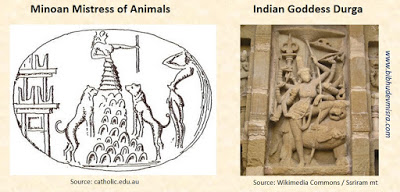
Fig 6: Minoan and Indian lion-riding Mountain Goddess.
Interestingly, one of the most well-known acts of goddess Durga was the slaying of the buffalo-demon Mahishasura, who bears an uncanny resemblance to the Cretan Minotaur, a creature with the head of a bull and body, who was confined in the center of the Labyrinth in Crete, receiving annual offerings of youths and maidens to eat, until he was killed by the Athenian hero Theseus. While the legend of Mahishasura and the Minotaur are quite different, their representations in art and sculpture are similar enough to raise eyebrows.
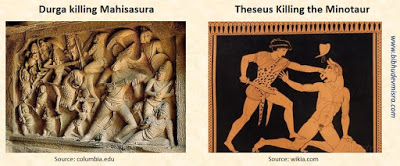
Fig 7: Mahishasura and the Minotaur
A lion-riding goddess of war and fertility, however, was popular all over the Middle-east such as Inanna (Sumeria), Ishtar (Assyria / Babylonia), Al-lat (Arabia), Astarte (Phoenicia) etc. from the very ancient times. So, the Cretan Mistress of Animals may have been influenced by the Middle-eastern cultures at an early stage, and subsequently by migrants from the Indus Valley.
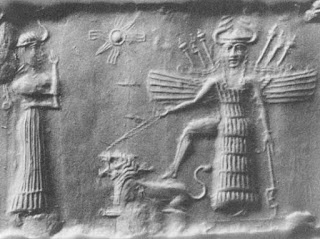
Fig 8: Ancient Akkadian cylinder seal depicting Inanna / Ishtar resting her foot on the back of a lion, while Ninshubur stands in front of her paying obeisance, c. 2334-2154 BCE. Public Domain image.
Tree Worship
The worship of sacred trees and boughs (i.e. branches broken from the trees) took a very prominent place in the Minoan religion. Although tree-worship was prevalent across the world, as shown by Sir James Frazer in The Golden Bough, the engravings on a number of Minoan gold rings show a close similarity to Buddhist iconography and customs.
The Ring of Minos from Knossos depicts a detailed tree worship scene. On the left, a Minoan woman is holding onto the branch of a sacred tree. She may be praying for fertility, for it was believed in the ancient world that holding the branch of a sacred tree promotes fertility and eases childbirth. In the nativity of Lord Buddha, his mother Maya Devi is shown holding the branch of an Ashoka tree. The Minoan lady can also be interpreted as the benevolent, wish-fulfilling, tree-spirit called yakshi, who is generally represented in Indian art as a voluptuous maiden entwined with the tree and holding on to a branch.
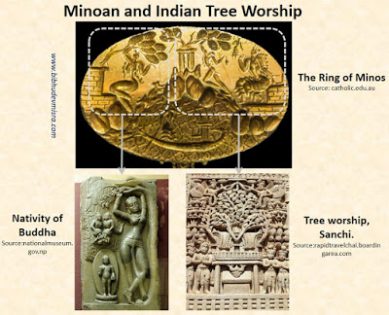
Fig 9: Tree-worship on the Ring of Minos and Indo- Buddhist art
In the center of the image on the Minoan ring, there is a sacred tree within an enclosure, which looks similar to the sacred tree in Buddhist sculptures. To the right of the sacred tree, a male helper appears to be plucking the fruit of the sacred tree, possibly with the intention of offering it to the seated female worshipper. This is a continuing tradition in India, where-in barren women consume the fruit of the sacred tree to promote conception. For instance, the mango tree occurs frequently amongst the sculptures of Bharhut stupa (c.184 BCE), and its fruit is believed to be symbolic of male progeny[4]. Since the Minoan sacred tree has been identified botanically as either fig or olive[5], the consumption of its fruit for promoting fertility may have been a prevalent custom.
The seated female worshipper is looking towards the sky at what seems to be an angelic figure. This is a common motif in Buddhist art, where angelic beings hover around the sacred tree, often carrying garlands and other offerings.
Minoan tree-worship customs and iconography, therefore, are very similar to that of India of the early historical period. Historians believe that Hindu-Buddhist tree worship practices are a continuation of Indus Valley traditions, for a tree-spirit is depicted on multiple Indus seals.
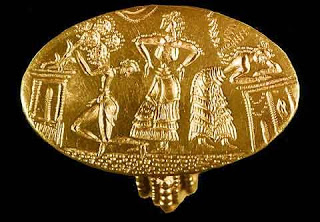
Fig 10: This ring from Tiryns shows a man holding a sacred tree which is planted in an enclosure containing a pillar / baetyl. Source: benedante.blogspot.in
A couple of more similarities caught my attention. On some Minoan rings, the tree grows out of a shrine which contains within it a sacred pillar, indicating that the pillar and the plant are symbolically interrelated.[6] This custom still prevails in India where a Shiva-Linga can be seen installed at the base of a peepal tree. Sir Arthur Evans had noted this connection, for he writes that, “In India, where worship of this primitive character is perhaps best illustrated at the present day, the collocation of tree and stone is equally frequent.”[7]
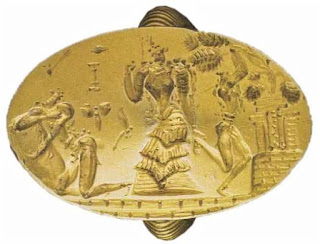
Fig 11: The Phourni ring shows a man embracing a rock, and another man grasping a tree, a while a lady worshipper looks on. Source: benedante.blogspot.in
A couple of more similarities caught my attention. On some Minoan rings, the tree grows out of a shrine which contains within it a sacred pillar, indicating that the pillar and the plant are symbolically interrelated.[6] This custom still prevails in India where a Shiva-Linga can be seen installed at the base of a peepal tree. Sir Arthur Evans had noted this connection, for he writes that, “In India, where worship of this primitive character is perhaps best illustrated at the present day, the collocation of tree and stone is equally frequent.”[7]
Some Minoan rings show a male or female figure kneeling and embracing a stone or pitcher near the sacred tree. This can be explained in the context of the worship ofShashti, the Hindu goddess of fertility and childbirth, for Shashti is worshipped by the rural folks in the form of a banyan tree, a red-colored stone placed below the sacred tree, or an earthenware pitcher.
Thus, Minoan tree-worship customs can be effectively explained through an analogy with ancient Indian practices. Although an ancient tree-goddess called Asherah (who was worshipped under trees or in the form of a sacred pole) was popular in Syria, Phoenicia and Canaan, very little is known of their specific customs or iconography in order to draw a parallel with Crete.
The Sacred Pillar
Pillar worship was an integral part of the Minoan religion. Caves were sacred places, and naturally formed pillars (stalagmites) in caves were worshipped by the Minoans since the Protopalatial Period (c.1900 BCE). A number of cult caves with rich votive offerings have been found, of which the most well-known is the “Cave of Eileithyia” which has a cylindrical stalagmite enclosed by a rectangular wall.
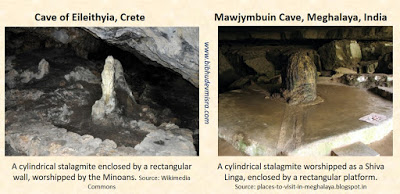
Fig 12: Worship of stalagmites inside cave sanctuaries in Crete and India.
Indians still worship stalagmites within caves as manifestations of Shiva, and many such cave shrines are scattered across the country. Whether it is the ice-stalagmite at the famous cave shrine of Amarnath in Kashmir, or the naturally formed stone stalagmite at the Gupteshwar cave in Orissa – they continue to draw thousands of pilgrims every year.
Every Minoan palace had a number of small, dark, rooms called “pillar rooms” or “pillar crypts”, which contained a central pillar (or two rectangular pillars) of ritual significance.A quadrangular channel (or depression) surrounded the central pillar in the royal palaces at Knossos and Hagia Triadha.[8] A pair of basins or vats were connected to the channel on opposite sides.

Fig 13: Pillar Crypt in the Royal Villa Knossos resembles the form of a Shiva Linga
This brings to mind the structure of a Shiva-Linga where the central pillar (symbolizing the cosmic form of Shiva as a fiery column of light) is surrounded by a channel which drains out the water offered as libation to the deity. In the Minoan pillar rooms, remains of large oil-jars have been found, which indicates that libations were offered to the pillar deity, which may have flowed through the channels into the basins. A pillar in the palace of Mallia in eastern Crete has a “trident” symbol engraved on it [9], which reinforces the connection with Shiva, since the trident is the foremost symbol of Shiva in modern iconography.
Shiva was worshipped in his pillar form since the Indus days. Pillar-shaped stones, resembling the Shiva-linga, have been found at Harappa and Kalibangan. At Dholavira, archaeologists have discovered circular huts with a limestone pillar base in the center(with a hole on top of the pillar), resembling the pillar rooms of the Minoan palaces.
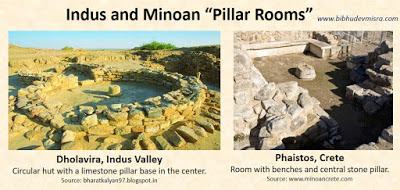
Fig 14: Pillar Rooms in the Indus Valley and Minoan Crete
While it is tempting to think that pillar worship in Crete was a result of an Indus Valley influence, it must be noticed that the Minoan pillars are square or rectangular in form as opposed to the rounded Shiva-Lingas of India. These kinds of square, sacred pillars were popular amongst the people of Syria, Canaan, and Arabia. The Suda Lexicon, which was compiled at the end of the 10th century, states:
“Theus Ares (Dushara): this is the god Ares in Arabic Petra. They worship the god Ares and venerate him above all. His statue is anunworked square black stone. It is four-foot high and two-feet wide. It rests on a golden base. They make sacrifices to him and before him they anoint the blood of the sacrifice that is their anointment.”
At the archaeological site of Tel Gezer in Israel, archaeologists have discovered aCanaanite “high place” where a row of ten, monumental, rectangular, standing stones, each of which is called a masseba or matseva (note the correlation between suffix seba / seva and Shiva) had been erected at around 1600 BCE. The Phoenician temples also had carefully wrought sacred columns; Herodotus states that the temple of Melkart at Tyre contained two sacred pillars.
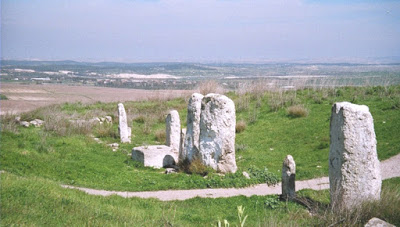
Fig 15: Tel Gezer stone pillars at a Canaanite “high place”. Source: Wikimedia Commons
The Hebrews also regarded stone pillars as a sacred representation or habitation of a deity. The Old Testament frequently records them raising sacred stones as monuments as a reminder of God’s covenant and for commemorating significant events. For instance:
“And Jacob rose up early in the morning, and took the stone that he had set up for his pillows, and set it up for a pillar, and poured oil upon the top of it. (Genesis 28; 18-19)
“And Joshua wrote these words in the book of the law of God, and took a great stone, and set it up there under an oak, that was by the sanctuary of the LORD” (Joshua 24;26).
The worship of stone pillars as a sacred representation of a deity was prevalent throughout the Middle-east since the very ancient times. It is possible, therefore, that Minoan pillar worship was initially influenced by the Middle-eastern cultures, with a subsequent Indus influence starting from around 1900 BCE.
The Horns of Consecration
The term “horns of consecration” was coined by Sir Arthur Evans to refer to the u-shaped, stylized rendering of a bull’s horns by the Minoans. Usually made of alabaster or clay, they were used for decorating altars and were displayed prominently on the roofs of palaces and peak sanctuaries in Neopalatial Crete. Horns of consecration were also used as decorative motifs on pottery, and as votive offerings at shrines.
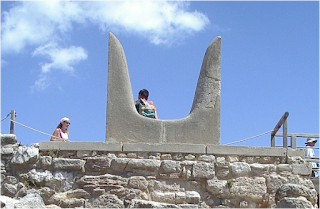
Fig 16: Reconstructed Horns of Consecration at Knossos made of porous limestone. Public Domain Image
The significance of the horns of consecration remain shrouded in mystery. Do they symbolize the horns of a bull, the distant mountain-tops of Crete, or hands raised in prayers? There is no unambiguous explanation for this sacred cult symbol.
My initial thinking was that the horns of consecration may symbolize Nandi – the bull of Shiva – who acts as Shiva’s vahana (carrier) and as a gatekeeper of Shiva’s abode. A stone image of a seated Nandi is generally installed in front of a Shiva temple, with the face of Nandi facing the main shrine. But this does not explain why the Minoans placed the u-shaped symbol on their altars and on top of the peak sanctuaries.
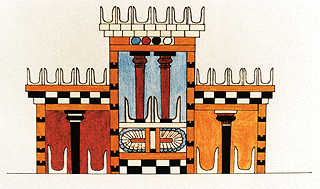
Fig 17: A reconstruction of the tripartite shrine found on the Procession fresco at Knossos. Source: http://antiquatedantiquarian.blogspot.in
I noticed that some of the stone pillars (masseba) raised by the Canaanites had a pair of horns on top. The “horned altar” of the Israelites used for burnt sacrificial offerings (incense, grains, wine, or animals) had horns at each of the four corners. In fact, some of horned altars discovered at the biblical site of Be’er Sheva look surprisingly similar to the Minoan horns of consecration! The u-shaped symbol, in both cases, have been fashioned out of two stone pieces joined together at the base.
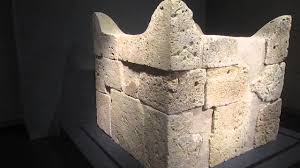
Fig 18: A reassembled horned altar at Tel Be’er Sheba. Source: Youtbe/ Zahi Shaked
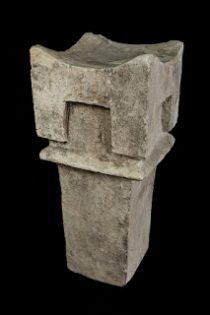
Fig 19: Horned Incense Altar found at Megiddo, 10th century BCE. Source: uchicago.edu
But what do the horns signify? Since the horns appears on top of pillars, or pillar-like stone altars, my guess is that it is probably a symbol associated with Shiva. In the Indus Valley depictions of Shiva as a seated yogi, he is shown wearing a horned head-dress. In modern depictions of Shiva, however, the horned head-dress is missing. What we find instead is a crescent moon in his matted locks, which is the source of amrita (nectar). The Phoenician war-goddess Astarte (the counterpart of the Babylonian Ishtar and Hindu Durga) also wears a crescent moon as a crown, resembling a pair of horns.
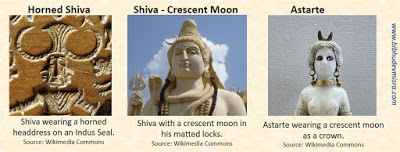
Fig 20: Horns and Crescent Symbols
The crescent moon also appears as a finial on top of Islamic mosques as well as some Hindu temples, just as the Minoan horns of consecration are placed at the apex of their peak sanctuaries. This custom was probably guided by the ancient cosmic conception that the temple spire represents the cosmic axis-mundi and the moon god was stationed on top of this axis. The incense altars of Saudi Arabia were built according to the same principle – the altar was either horned or had a crescent moon inscribed on top. Nannar, the Sumerian Moon-god (who later became identified with Sin, the Moon-god of the Assyrians and Babylonians) was depicted with a crescent moon on his crown, pillars topped with crescent signs, and horned altars.
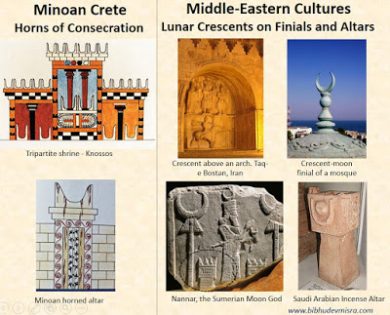
Fig 21: Horns of Consecration and Crescent Symbols
It is very likely, therefore, that the u-shaped horns of consecration of Minoan Crete were a stylized rendering of the crescent moon on top of the cosmic axis-mundi. The stylistic similarity of this symbol with the Canaanite and Israelite renditions suggests that, in this respect, the Cretans may have been influenced by the Middle-eastern cultures.
Bull Sacrifice
Although the so-called horns of consecration did not have anything to do with bulls, it is well-known that bulls played an important part in Minoan society. The Minoans sacrificed bulls as part of their funerary rites, as depicted on the Hagia Triadha sarcophagus. Indus Valley seals also indicate a funerary custom of sacrificing water buffaloes.
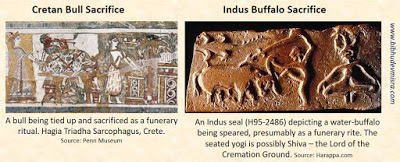
Fig 22: Minoan and Indus bull / buffalo sacrifice
This practice continues amongst many tribal societies of India and South Asia, as documented by Francesco Brighenti in his informative article.[10] It appears that the tribals believe that the spirit of the sacrificed water buffalo acts as a “supernatural guide” of the soul of the deceased in its journey to the underworld. The afterworld, itself, was sometimes conceived of as a celestial buffalo, where the clan’s ancestral spirits assembled. Bull sacrifice was widely dispersed in the ancient world, and it is likely that it was an ancient custom of Crete
A Multicultural Minoan Society
One of the surprising aspects of the Minoan and Indus cultures is the absence of any signs of warfare. No implements of war have been found, no depictions of soldiers, fighting, or captives are to be seen on their pottery, frescoes, rings, or seals. Both cultures appear to have been peace-loving, industrious, and technologically advanced, practicing simple rites, free of ostentatiousness. The Swastika symbol has been found in profuse numbers in both cultures, indicating a propensity towards peace, good luck, and well-being.
Women enjoyed an elevated status in both Minoan and Indus society. On Minoan frescoes, women are shown dressed ornately and participating in public life. At the Indus sites, archaeologists have found terracotta female figurines adorned with jewelry and elaborate head-dresses, indicative of high social status.
A Minoan fresco shows a dignified female, possibly the Minoan queen, being carried through a crowd on a palanquin, quite like the Indian kings and queens who were carried around on a palanquin on ceremonial or religious occasions. A Cretan gem engraving shows a “woman blowing a shell trumpet before an altar with horns of consecration, apparently to invoke the presence of the gods.”[11] As is well-known, the blowing of a conch shell in a ritualistic context still continues in the Hindu-Buddhist religion.
The Minoan society, quite strikingly, was multicultural. The frescoes depict an admixture of men and women with white and brown complexion, participating in cultural and religious activities. This is one of the reasons why, when Sir Arthur Evans had discovered Palace of Knossos in Crete in 1900, he had surmised that the Minoans may have been refugees from the delta region of Egypt.
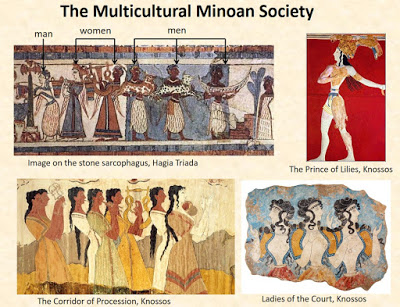
Fig 23: The multicultural Minoan society
Recent genetic studies based on mitochondrial DNA markers, however, refute Arthur Evans’s North African hypothesis. It seems that the early population of Crete descended from the Neolithic people who migrated to Europe from the Middle East and Turkey starting from around 7000 BCE.[12] Wolfgang Haak, a molecular archaeologist at the University of Adelaide in Australia, thinks that Crete’s early history is complicated, with multiple Neolithic populations arriving at different times.[13]
Neolithic migrations from the Middle East could account for some of the early cult symbols of the Minoans such as the sacred pillars, the horns of consecration, and the lion-riding deity known as the Mistress of Animals who was worshipped in peak sanctuaries.
However, another migration into Crete may have taken place at a later date – sometime before the beginning of the Neopalatial Period at around 1700 BCE. This migration, possibly from the Indus Valley, has not yet been considered by archaeologists, and has been generally overlooked in genetic studies.
The Indus migrants may have brought into Minoan Crete a number of technological innovations and religious practices such as advanced water management techniques, the lost-wax method of bronze casting, the bull-leaping sport, the worship of the Snake Goddess, Pillar Worship in cave sanctuaries, and Tree Worship rituals. The depiction of white and brown-skinned people on Minoan frescoes is an important indicator of this migrant population.
Interestingly, the Minoan Linear A script as well as the Indus script are still undeciphered. What makes this coincidence even more striking is that some of the Linear A signs look exactly like those of the Indus script. According to Dr. Gareth Alun Owens, Linear A represents the Minoan language, which Owens classifies as a distinct branch of Indo-European with strong connections to Sanskrit. At “The Cretan Literature Centre”, Dr. Owens stated:
″Beginning our research with inscriptions in Linear A carved on offering tables found in the many peak sanctuaries on the mountains of Crete, we recognise a clear relationship between Linear A and Sanskrit, the ancient language of India. There is also a connection to Hittite and Armenian. This relationship allows us to place the Minoan language among the so-called Indo-European languages, a vast family that includes modern Greek and the Latin of Ancient Rome.”[14]
In my opinion, the coastal Indus sites like Dholavira or Lothal are the most likely sources of the migrant population to Crete. Dholavira has a number of conspicuous parallels with the Minoan civilization, as already pointed out. Besides, the migration to Crete is likely to have been accomplished by sea-faring traders, who probably sailed across the Indian Ocean and up the Red Sea to reach Avaris, the capital of the Hyksos in the Nile Delta, and from there sailed down the Nile to the Mediterranean Sea, and reached Crete.
The hypothesis highlights an important historical event that has been generally ignored in cultural studies – the collapse of the Indus Valley civilization at around 1900 BCE, and the subsequent migrations out of this densely populated ancient civilization. It had a far-reaching effect in taking Indic culture to distant shores, the signs of which are visible even today.
End Notes
[1] “Excavations-Dholavira”, Archaeological Survey of India <http://asi.nic.in/asi_exca_2007_dholavira.asp>
[2] Bibhu Dev Misra, “Bull-Leaping: Did it spread from the Indus Valley to Syria, Egypt, and Crete?” 13 Jan 2017 <http://www.bibhudevmisra.com/2017/01/bull-leaping-did-it-spread-from-indus.html>
[3] Thomas E. Donaldson, Iconography of the Buddhist Sculpture of Orissa (Abhinav Publications, 2001) 405.
[4] Pradyot Kumar Maity, Human Fertility Cults and Rituals of Bengal: A Comparative Study, (Abhinav Publications, 1989) 181
[5] Carole M. Cusack, The Sacred Tree: Ancient and Medieval Manifestations (Cambridge Scholars Publishing, 2011) 33.
[6] Marija Gimbutas, The Goddesses and Gods of Old Europe, 6500-3500 B.C.: Myths and Cult Images (University of California Press, 2007) 80.
[7] Arthur John Evans, The Mycenaean Tree and Pillar Cult and Its Mediterranean Relations (Cambridge University Press, 2013) 8
[8] Marija Gimbutas, The Goddesses and Gods of Old Europe, 6500-3500 B.C.: Myths and Cult Images (University of California Press, 2007) 79.
[9] Martin Persson Nilsson, The Minoan-Mycenaean Religion and Its Survival in Greek Religion (Biblo & Tannen Publishers, 1950) 242
[10] Francesco Brighenti, “Buffalo Sacrifice and Tribal Mortuary Rituals”, Svabhinava.org 10 March 2007 <http://www.svabhinava.org/friends/FrancescoBrighenti/BuffaloSacrifice-frame.php>
[11] Martin Persson Nilsson, The Minoan-Mycenaean Religion and Its Survival in Greek Religion (Biblo & Tannen Publishers, 1950) 220
[12] Hughey, J. R. et al. A European population in Minoan Bronze Age Crete. Nat. Commun. 4:1861 doi: 10.1038/ncomms2871 (2013).
[13] Ewen Callaway,”Minoan Civilization Originated in Europe, Not Egypt” Nature Magazine 15 May 2013 <http://www.scientificamerican.com/article/minoan-civilization-origin-europe-not-egypt/>
[14] “Linear A” in Wikipedia.
This article was first published at the author’s personal blog.
Bibhu Dev Misra
Latest posts by Bibhu Dev Misra (see all)
- Hercules and Balarama: The Symbolic and Historical Connections - October 23, 2024
- Indus Valley Cultural Elements in Minoan Crete: Was it Due to Migration? - October 23, 2024
- Comet Impact in Indian Ocean Submerged Krishna’s Dwaraka? An Insight - October 23, 2024

